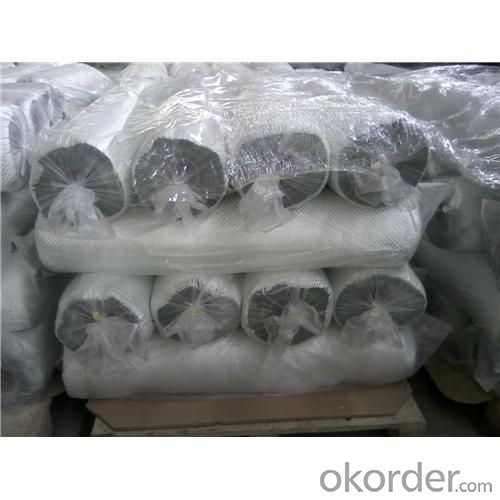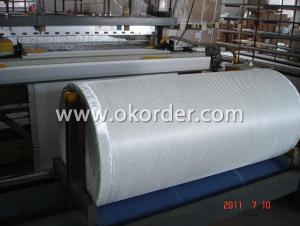Fiberglass Fabrics Ewr360-380g/m2
- Loading Port:
- China Main Port
- Payment Terms:
- TT or LC
- Min Order Qty:
- 10Ton kg
- Supply Capability:
- 100TON PER TON kg/month
OKorder Service Pledge
OKorder Financial Service
You Might Also Like
Specifications of EWR360-380G/M2
1.Weight:360-380g/m2
2.Width:90cm
3.Length:100meter/roll
4.Packing:Plastic bag + Plastic woven bag
Characteristics of EWR360-380G/M2
1.Low Fuzz,dirt,impurity and other stains.
2. Fast wet-out.
3. Even thickness
4.Good covering
5.Passed ISO9001,ISO14001
Application of EWR360-380G/M2
a) boats ,vessels ,plane
b) automotive parts ,furniture and sports facilities
c) resins system,such as polyeser,vinylester and epoxy resins
<IMG title=EWR360-380G/M2 alt=EWR360-380G/M2 src="https://file2.okorder.com/prod/2013/12/12/0fe9e6e5c192f505a80fe749302d42e4/97629bbe0f243153ffc9c620d481059c.jpg" _src="https://file2.okorder.com/prod/2013/12/12/0fe9e6e5c192f505a80fe749302d42e4/97629bbe0f243153ffc9c620d481059c.jpg">
<IMG title=EWR360-380G/M2 alt=EWR360-380G/M2 src="https://file2.okorder.com/prod/2013/12/12/9892a2f3166ed0d08f5f9768de96b58d/cfad0ded1db7312d1d8f171c98b6f1d8.jpg" _src="https://file2.okorder.com/prod/2013/12/12/9892a2f3166ed0d08f5f9768de96b58d/cfad0ded1db7312d1d8f171c98b6f1d8.jpg">
- Q: Can fiberglass fabric be used for making sports helmets?
- Yes, fiberglass fabric can be used for making sports helmets.
- Q: The influence of bag dust removal on dust filtration
- The filter speed V (or than the load QF) is an important technical and economic index representing the capacity of the bag filter to treat gas. The selection of filtration rate should take account of economy and the requirement of filter efficiency. From the economic considerations, the filtration rate is high, with the same flow gas required filter area is small, then the size of the dust remover, the area, the steel consumption is also small, so the investment is small, but the pressure loss, power consumption, damage dust filter increases, because of high operating costs. From the aspect of dust filtration efficiency, the influence of filtration rate is remarkable. Some experiments show that the filtration rate increases by 1 times, and the dust passing rate may increase by 2 times or even more than 4 times. So the filter speed is usually expected to be lower. The filter speed of the fabric filter cloth is 0.5 ~ 2m/min, and the felt filter material is 1 ~ 5m/min. From the two aspects of economy and efficiency, this filter speed range is the most appropriate. When the filtration rate increases, it will intensify the penetration of dust particles by three ways, namely, through, extrusion and air holes, thereby reducing the dust removal efficiency.
- Q: Is fiberglass fabric suitable for use in automotive interiors?
- Yes, fiberglass fabric is suitable for use in automotive interiors. Fiberglass fabric is known for its durability, strength, and resistance to heat and fire. These characteristics make it an excellent choice for automotive interiors, where it can withstand the wear and tear of daily use and provide a high level of protection. Fiberglass fabric is commonly used in automotive interiors for various purposes. It can be used as a reinforcement material for the seats, headliners, door panels, and other interior components. Its high tensile strength ensures that the fabric can withstand the pressure and stress placed on these parts, ensuring their longevity. Additionally, fiberglass fabric is often used as a sound and heat insulator in automotive interiors. Its thermal properties help to reduce heat transfer, keeping the cabin cooler in hot weather. It also helps to dampen sound vibrations, providing a quieter and more comfortable driving experience. Furthermore, fiberglass fabric is resistant to moisture, mold, and mildew, making it ideal for use in automotive interiors that are exposed to varying weather conditions. It is also easy to clean and maintain, which is crucial for maintaining the aesthetics and functionality of the interior components. Overall, fiberglass fabric offers numerous advantages that make it suitable for use in automotive interiors. Its strength, durability, heat resistance, and insulating properties make it a popular choice among manufacturers and designers looking to create high-quality, long-lasting, and comfortable automotive interiors.
- Q: Can fiberglass fabric be used for gloves?
- Gloves can indeed utilize fiberglass fabric. This particular fabric is renowned for its exceptional durability and ability to withstand high temperatures, which makes it ideal for a wide range of industrial uses, including gloves. These gloves are commonly found in industries like manufacturing, automotive, and construction, where workers require protection against sharp objects, hot surfaces, and chemicals. To enhance their protective properties and provide comfort, the fiberglass fabric used in these gloves is typically coated or lined with a heat-resistant material. Nevertheless, it is crucial to be aware that some individuals may experience skin irritation or allergies when exposed to fiberglass fabric. In such cases, it is advisable to take proper precautions, such as wearing a liner glove or opting for gloves made from alternative materials.
- Q: How does fiberglass fabric perform in abrasive environments?
- Fiberglass fabric performs exceptionally well in abrasive environments due to its high strength, durability, and resistance to wear and tear. The fabric's unique composition of glass fibers provides excellent resistance against abrasion, ensuring its longevity and performance even in harsh conditions.
- Q: What are the different lamination options available for fiberglass fabric?
- There are several lamination options available for fiberglass fabric, depending on the specific requirements and applications. Some of the common lamination options include: 1. Polyester Resin Lamination: This is the most commonly used lamination option for fiberglass fabric. Polyester resin is applied to the fabric, forming a strong and durable bond. It provides good chemical resistance and is suitable for applications where high strength is required. 2. Epoxy Resin Lamination: Epoxy resin lamination offers superior strength and excellent adhesion. It is often used in applications that require high-performance and resistance to harsh environmental conditions. Epoxy resin also provides good chemical and heat resistance. 3. Polyurethane Lamination: Polyurethane lamination offers flexibility and excellent abrasion resistance. It is commonly used in applications that require fabric flexibility and durability, such as inflatable structures or protective clothing. 4. Vinyl Ester Resin Lamination: Vinyl ester resin is a hybrid between polyester and epoxy resins, offering high strength and excellent corrosion resistance. It is commonly used in applications exposed to harsh chemicals or environments, such as chemical storage tanks or marine applications. 5. Thermoplastic Lamination: Thermoplastic lamination involves the use of heat and pressure to bond a thermoplastic film onto the fiberglass fabric. This option provides good chemical resistance and is often used in applications that require waterproofing or resistance to environmental elements. It is important to consider the specific requirements and intended use of the fiberglass fabric when choosing the appropriate lamination option. Factors such as strength, flexibility, chemical resistance, and environmental conditions will help determine the most suitable lamination choice.
- Q: Can fiberglass fabric be used for reinforcement in underground storage tanks?
- Indeed, reinforcement in underground storage tanks can be achieved through the utilization of fiberglass fabric. Renowned for its exceptional corrosion resistance and high strength-to-weight ratio, fiberglass fabric emerges as an optimal selection for this purpose. The incorporation of fiberglass fabric not only enhances the structural integrity of the tank but also mitigates the risk of potential failures or leaks. Additionally, the ease of handling and installation of fiberglass fabric renders it a practical and cost-efficient solution for reinforcing underground storage tanks.
- Q: Can fiberglass fabric be used for making heat shields?
- Yes, fiberglass fabric can be used for making heat shields. Fiberglass fabric is known for its excellent heat resistance properties, making it an ideal material for heat shielding applications. It can withstand high temperatures without melting or deforming, providing a protective barrier against heat transfer. Additionally, fiberglass fabric is lightweight, flexible, and has good insulation properties, making it suitable for various heat shield applications, such as in automotive, aerospace, and industrial settings.
- Q: How long does fiberglass fabric typically last?
- Fiberglass fabric possesses a reputation for its durability and longevity, making it a favored choice across various applications. The duration of its lifespan is contingent upon several factors, including fabric quality, exposure to external elements, and maintenance measures. On average, fiberglass fabric can endure for anywhere between 10 to 30 years. However, by implementing appropriate care and maintenance, it is feasible for its longevity to surpass these estimations. Consistent cleaning, prevention of excessive exposure to harsh chemicals or extreme temperatures, and avoidance of physical harm are all instrumental in significantly extending the lifespan of fiberglass fabric. It is crucial to acknowledge that fiberglass fabric can become brittle and compromise its structural integrity over time, particularly when subjected to continuous high temperatures or harsh environmental conditions. Moreover, natural wear and tear can contribute to its eventual deterioration. To guarantee the utmost longevity for fiberglass fabric, it is advisable to adhere to the manufacturer's maintenance and care guidelines. Regular inspections to identify signs of damage or wear, along with immediate repairs or replacements when necessary, can greatly contribute to prolonging the fabric's lifespan.
- Q: How is fiberglass fabric used in the production of electrical cables?
- Fiberglass fabric is commonly used as an insulation material in the production of electrical cables. It provides excellent thermal and electrical insulation properties, protecting the cables from heat and preventing the leakage of electric current. The fiberglass fabric is typically wrapped around the conductor, acting as a protective barrier and ensuring the safe and efficient transmission of electricity.
1. Manufacturer Overview
| Location | Shanghai,China |
| Year Established | 2006 |
| Annual Output Value | Above US$20 Million |
| Main Markets | Mid East;Western Europe;North America:South American |
| Company Certifications |
2. Manufacturer Certificates
| a) Certification Name | |
| Range | |
| Reference | |
| Validity Period |
3. Manufacturer Capability
| a) Trade Capacity | |
| Nearest Port | Shanghai |
| Export Percentage | 70% |
| No.of Employees in Trade Department | 200 People |
| Language Spoken: | English;Chinese |
| b) Factory Information | |
| Factory Size: | Above 400,000 square meters |
| No. of Production Lines | Above 15 |
| Contract Manufacturing | Average |
| Product Price Range | OEM Service Offered;Design Service Offered |
Send your message to us
Fiberglass Fabrics Ewr360-380g/m2
- Loading Port:
- China Main Port
- Payment Terms:
- TT or LC
- Min Order Qty:
- 10Ton kg
- Supply Capability:
- 100TON PER TON kg/month
OKorder Service Pledge
OKorder Financial Service
Similar products
Hot products
Hot Searches
Related keywords



























